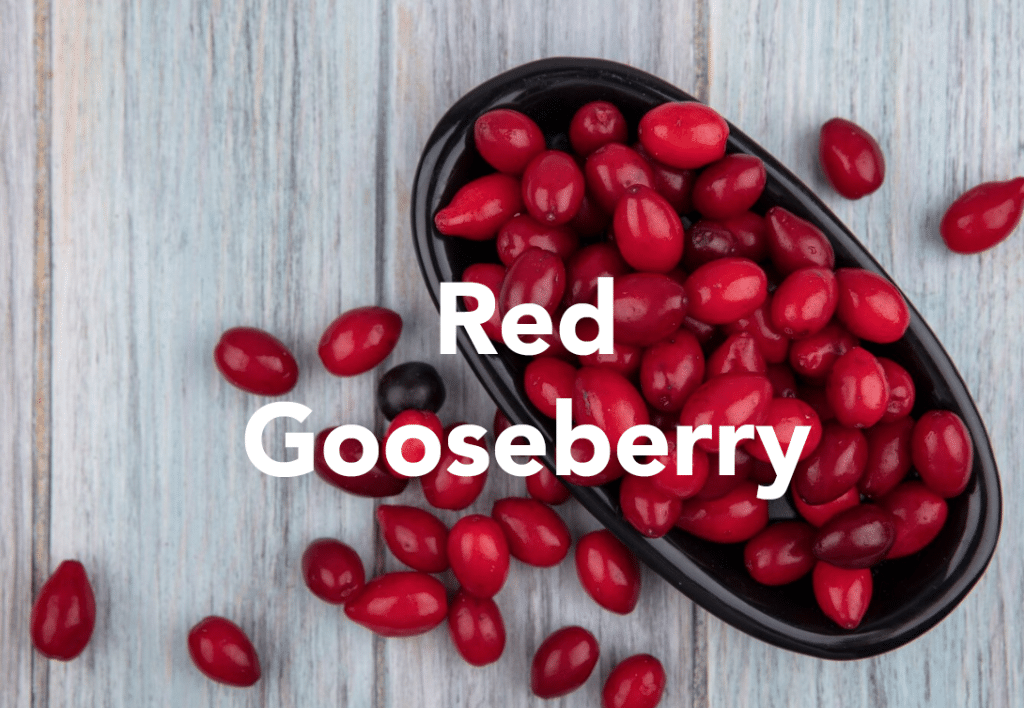Red Gooseberry is a common name for many species of Ribes including currants, as well as a large number of plants of similar appearance. The berries of those in the genus Ribes are edible and may be green, orange, red, purple, yellow, white, or black.
Red gooseberry is an auto-fertile bearing bush with prickly stems, with dark, juicy red currants commencing in July, the size of a cherry. Red gooseberries are a delicious and versatile fruit, great for eating fresh, making jams, jellies, and desserts, or adding to savory dishes. The berries are soft when ripe and will squeeze easily between your fingers.
Red gooseberries typically grow on bushes rather than trees. Gooseberry bushes are small, thorny shrubs producing tart, flavorful berries.
Characteristics of Red Gooseberry Bushes
Gooseberry bushes are usually 3-5 feet tall and wide, exceptionally hardy, resistant to harsh cold, and resistant to powdery mildew. The leaves are lobed and green, turning yellow in the fall. Most varieties have small thorns along their branches. They produce small, bell-shaped flowers in the spring.
Planting
Planting Time:
Plant gooseberry bushes in early spring or fall when the soil is workable.
Location:
Pick a sunny area with well-draining soil. Partial shade is also favorable in hot weather conditions.
Soil:
Mix compost with soil before planting. A slightly acidic to neutral soil (pH 6.0-6.5) is acceptable.
Spacing:
Spacing of 4-5 feet ensures adequate air circulation.
Planting Steps
Create a hole big enough to accommodate the root system. Mix in the compost. Place the shrub in the hole at the same depth as it grew in the container. Spread the roots and gently firm the dirt in. After planting, water thoroughly to settle the dirt around the roots.
Care and Maintenance
Watering:
Keep the soil moist but not soggy, especially during dry periods.
Mulching:
Put a layer of mulch around the base of the shrub to maintain moisture and suppress weeds.
Fertilizing:
In early springtime, apply a balanced fertilizer or compost to the plant’s base.
Pruning should be done in late wintertime or early spring to remove dead or crossed branches and shape the bush, improving air circulation and fruit yield.
Pest and disease control:
Scout for common pests like aphids, sawfly larvae, and diseases like powdery mildew. Use organic or chemical controls as needed.
Popular Red Gooseberry Varieties
- Hinnonmaki Red: Known for its sweet-tart flavor and good disease resistance.
- Invicta: Vigorous and high-yielding with large, sweet berries.
- Jahn’s Prairie: A hardy variety with good disease resistance and flavorful berries.
Harvesting
Timing:
Red gooseberries are usually ready for harvest in mid to late summertime, depending on the variety and growing conditions.
Method:
Pick the berries carefully to avoid damaging the plant. Ripe berries will be firm and full-colored.
Culinary Uses
Fresh Eating:
Red gooseberries can be eaten fresh off the bush. They have a tart flavor that is refreshing and enjoyable.
Jams and Jellies:
Gooseberries are ideal for creating jams and jellies because of their high pectin content. They set easily and have a rich, tangy flavor.
Pies and Desserts:
Use red gooseberries in pies, tarts, crumbles, and other baked goods. They add a unique tartness that balances the sweetness of desserts.
Sauces and Compotes:
Gooseberries make excellent sauces and compotes served with meats, poultry, or desserts when cooked with sugar.
Juices and Syrups:
Gooseberries can be juiced or made into syrups. These can be used in beverages, cocktails, or toppings for pancakes and waffles.
Preserves and Chutneys:
Gooseberries can be made into preserves or chutneys, which are great for adding a tangy twist to savory dishes or serving with cheese and crackers.
Nutritional Benefits of the Red Gooseberry
Gooseberries are a source of vitamin C, crucial for immune function and skin health. They provide dietary fiber, aiding in digestion and promoting a healthy gut. Gooseberries contain antioxidants that help protect the body against free radicals and oxidative stress. They are a low-calorie fruit, making them a healthy snack option.
Medicinal Uses
Traditionally, gooseberries have been used for their medicinal properties, including:
Digestive Health:
The fiber in gooseberries helps with digestion and can relieve constipation.
Anti-Inflammatory:
The antioxidants and vitamins in gooseberries have anti-inflammatory effects, which can benefit overall health.
Blood Sugar Regulation:
Blood Sugar Regulation: According to some research, gooseberries can help regulate blood sugar levels, making them advantageous for diabetic patients.
Tips for Using Red Gooseberry
Due to their tartness, Gooseberries may need to be sweetened when used in recipes by adjusting the sugar content based on your preferences and the specific use.
Gooseberries pair well with ingredients like strawberries, rhubarb, apples, vanilla, and spices such as cinnamon and ginger.
Read about
1. Mushroom Supplements, Best, Benefits and Side Effects here.
2. Lion Mane Mushroom Powder here.

